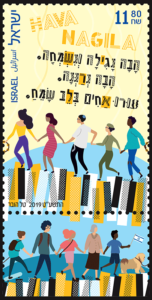 Date of Issue: 01 May 2019
Date of Issue: 01 May 2019
Size of stamp: W: 35 mm H: 50 mm
Face Value: NIS 11.80
Plate Block No. 1115
Designer: Tal Hoover
Printing Method: Offset
Printer: Cartor Security Printing, France
Sheet Type: Regular- Mini Sheet
Stamps per sheet: 10
Tabs: 5
No. of FDCs: 1
Price of FDCs: NIS 13
Place of cancellation: Jerusalem
Hava Nagila is one of the most famous Hebrew songs in the world, arguably the most recognized of all Hebrew melodies. The lyrics were apparently written by composer Zvi Idelsohn and his students at the Lemel School. Idelsohn was the first professional Jewish composer in Jerusalem and in all of Eretz Israel. He was also a vocal and music teacher, musical arranger, choir conductor, cantor and mentor to young cantors. In addition, he researched Jewish music, meticulously collecting and compiling thousands of Jewish melodies from all of the Jewish ethnic groups and tribes and was the first to record music in Eretz Israel.
The song was composed when 400 years of oppressive Turkish rule in Eretz Israel came to an end and the Jews of Jerusalem were enthusiastic and joyful after the British troops led by General Edmond Allenby entered the city on the first day of Hanukkah, 1917. During such moments of joy the Hallel prayer of praise is recited in synagogue: “This is the day that the Lord has made; let us exult and rejoice on it”.
Idelsohn decided to compose a song in honor of this great event and arranged the melody based on a Hasidic tune that he heard in the Hasidic court of the Sadigura Rebbe. The ancient melody stems from the courts of the Chernobyl Hasidic dynasty and was heard in most Hasidic courts.
 The song was first performed in 1918. It was later performed by many different artists, Jews and non-Jews alike. The melody was played at a dance in Jerusalem that same year, to great success. The words of the chorus are: “Let us rejoice and be glad, let us be happy, awaken brethren with a cheerful heart”.
The song was first performed in 1918. It was later performed by many different artists, Jews and non-Jews alike. The melody was played at a dance in Jerusalem that same year, to great success. The words of the chorus are: “Let us rejoice and be glad, let us be happy, awaken brethren with a cheerful heart”.
The song was recorded in the 1920’s and spread among the Jewish communities of Europe and America. It reached New York, a center for Jews and also the music world, and quickly gained popularity. The catchy, rhythmic tune and the simple Hebrew lyrics made it a hit among the Jewish population and it became the core of Jewish celebrations, sung at weddings, bar and bat mitzvahs, etc.
Non-Jewish singers also embraced and performed the song, thus expanding its popularity in the United States and later throughout the world, and it eventually became a musical standard. Although lyrics have been written in other languages, most renditions of the song feature all of the Hebrew lyrics and it is probably the most recognized Hebrew song in the world.
The First Day Cover features part of the musical score to Hava Nagila.



